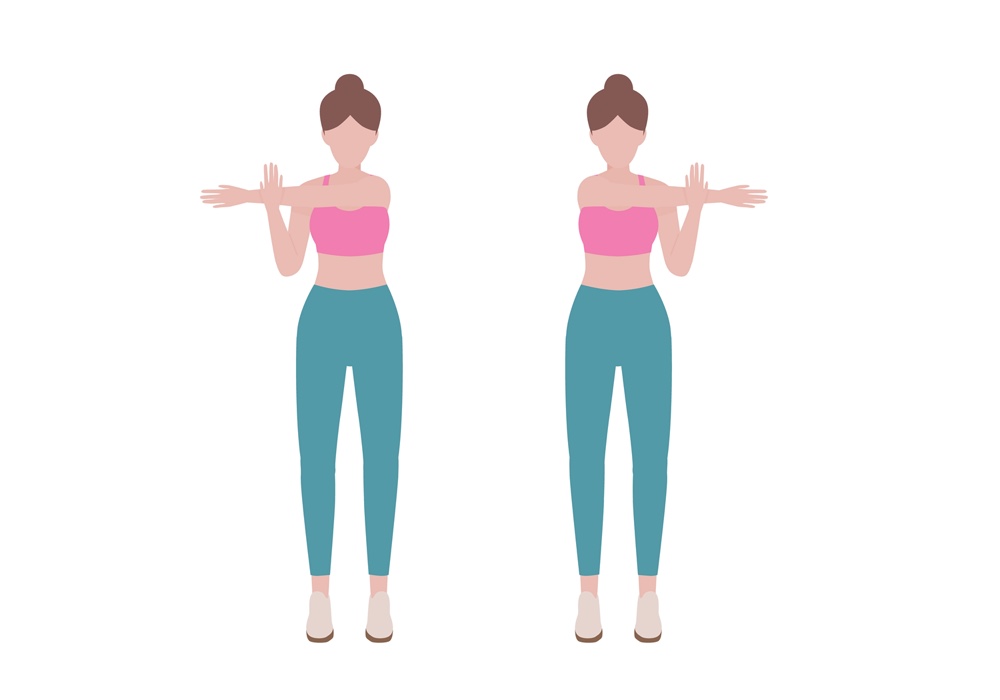By
Amber Lanahan
Professional Insight Provided by:
Larissa Castro, PT and Eduardo Cardenas, PT
As we grow older and juggle increasingly demanding schedules, our bodies often struggle to keep pace. Tight shoulders, stiff knees, and sore backs are just a few of the common complaints that come with daily wear and tear. The good news? A few simple physical therapy exercises – done right in the comfort of your home – can help alleviate discomfort, promote flexibility, and strengthen key muscle groups.
Here are a variety of targeted movements that will help you stay limber and keep those nagging aches at bay:
For Your Hands
Typing, texting, and everyday tasks can take a toll on your hands and fingers.
Knuckle Bend
- Hold your hand and fingers straight, keeping them close together.
- Bend the middle joints of your fingers while keeping your knuckles straight.
- Slowly return to the starting position. Repeat 5 times per hand.
Finger Walk
- Place your hand palm-down on a flat surface.
- Move your thumb away from your fingers, then “walk” your fingers one at a time toward your thumb.
- Repeat 5 times for each hand, moving slowly and smoothly.
For Your Shoulders
Whether it’s from sitting at a desk or lifting heavy grocery bags, shoulder stiffness is common.
Range of Motion Exercise
- Let your arm hang down and swing it like a pendulum – forward, backward, and in circles.
- Or “walk” your arms up a wall, mimicking a spider climbing upward.
Shoulder Stretch
- Bring your left arm across your chest and hold it with your right arm, above or below the elbow.
- Hold for 30 seconds, then switch sides.
For Your Knees
Your knees carry you everywhere, so treat them kindly.
Straight Leg Lift
- Lie on your back with one leg bent, the other straight.
- Tighten your thigh muscle and lift the straight leg about 12 inches off the floor.
- Hold for 3-5 seconds, then lower. Repeat and switch legs.
Hamstring Curls
- Holding a chair for balance, lift your heel toward your buttocks.
- Hold for 3-5 seconds. Lower and repeat, then switch legs.
Step-Ups
- Using a 6-inch platform, step up with one foot and let the other foot hang off the edge.
- Hold for 3-5 seconds, then step down. Alternate sides.
For Your Back
Prolonged sitting or standing can create tension and soreness in your lower back.
Child’s Pose (Prayer Stretch)
- From a crawling position, lower your hips toward your heels.
- Feel a gentle stretch through your back and glutes.
Knee-to-Chest Stretch
- Lie on your back with bent knees.
- Pull one knee toward your chest and hold for 5 seconds. Repeat with the other leg, then both legs together.
Seated Lower Back Rotational Stretch
- Sit on a chair, cross one leg over the other.
- Use your opposite elbow against your knee to gently twist and stretch your back.
- Hold for 10 seconds and repeat on both sides.
For Your Neck
Neck tension is a common result of stress or poor posture.
Neck Stretch
- Gently tilt your head forward and to the right, using your right hand to enhance the stretch on the left side.
- Hold for 30 seconds, then switch sides.
Head Pulls
- Slowly roll your head side to side, ear to shoulder, pausing briefly at each side.
- Complete three gentle clockwise and counterclockwise circles.
Compound Movements for Full-Body Strength
Compound exercises engage multiple muscle groups at once, improving both strength and coordination.
Bridges
- Lie on your back with knees bent.
- Press your hips upward, squeezing your glutes and engaging your core.
- Slowly lower back down.
Squats
- Stand with feet shoulder-width apart.
- Lower your hips as if sitting into a chair, keeping your back straight and weight in your heels.
- Rise back up to standing, making sure your knees stay behind your toes.
Wall Push-Ups
- Stand facing a wall, arms extended, palms touching the surface.
- Slowly bend your elbows, bringing your chest closer to the wall. Straighten to return.
Traditional Push-Ups
- In a prone position, push yourself up off the floor, maintaining a straight line from head to toe.
- Lower and repeat.
Remember, consistency is key. Performing these exercises regularly can help ease soreness, boost your mobility, and enhance your overall wellness. As always, consult with a licensed physical therapist before beginning any new exercise routine to ensure you’re moving safely and effectively.
Stay strong, stay active, and keep moving!
















